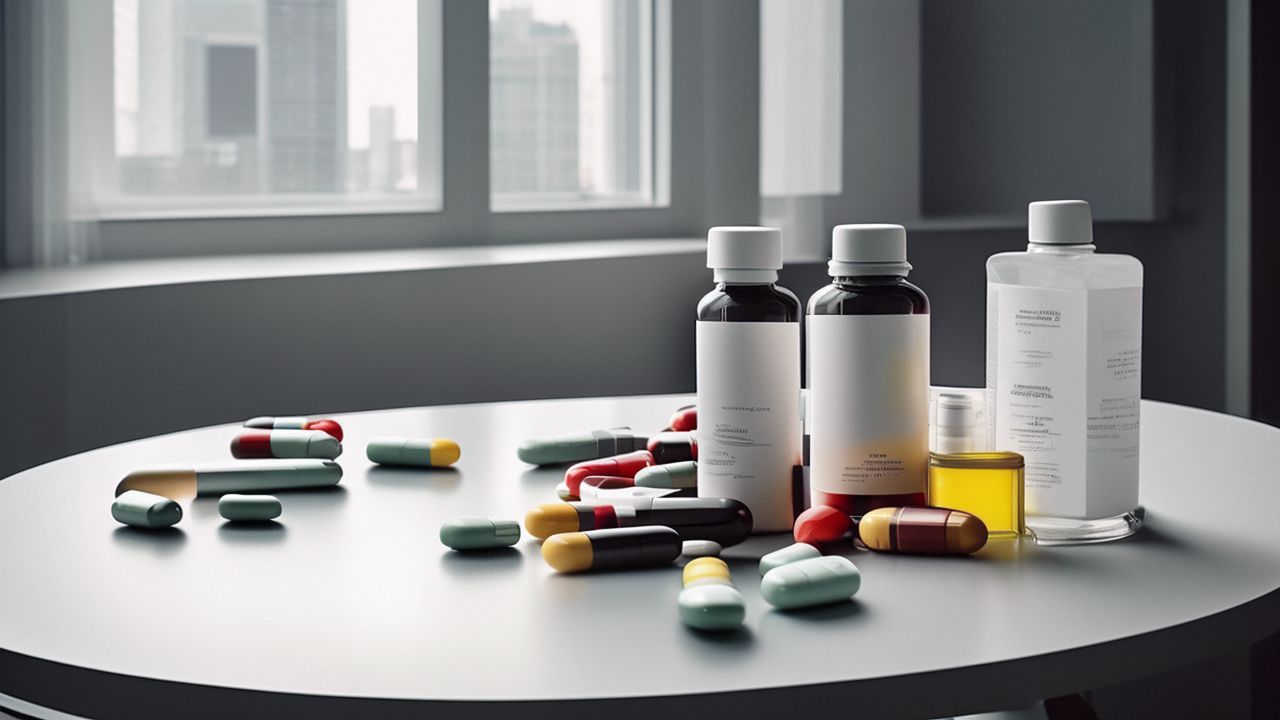Gliclazide: Side effects, precautions, and manufacturer
Introduction:
Gliclazide is an oral hypoglycemic agent commonly used in the treatment of type 2 diabetes. It belongs to the sulfonylurea class of drugs and works by stimulating the release of insulin from the pancreas, thereby reducing blood glucose levels. Gliclazide has been widely prescribed due to its effectiveness and relatively fewer side effects compared to other antidiabetic medications.

Research and Development Journey:
The journey of gliclazide began in the 1970s when it was first synthesized. After extensive research and clinical trials, gliclazide was approved for medical use in the 1980s. Since then, it has become a popular choice for the management of type 2 diabetes. The development of gliclazide was a significant advancement in the field of diabetes treatment, as it offered a better option with fewer side effects than its predecessors.
American Manufacturers and Pricing:
In the United States, gliclazide is manufactured by various pharmaceutical companies. One of the prominent manufacturers is Sanofi Aventis, which markets gliclazide under the brand name Diabinese. The pricing of gliclazide varies depending on the brand, dosage strength, and market demand. Generally, the cost of gliclazide ranges from 30-100 for a month’s supply, which is relatively affordable compared to other newer antidiabetic drugs.
Market Size:
The global market for gliclazide has experienced significant growth due to the rising prevalence of diabetes worldwide. According to market research reports, the diabetes drug market is projected to reach billions of dollars by the end of the decade. Gliclazide, being a well-established medication, holds a substantial share in this market. Its effectiveness, safety profile, and affordable pricing contribute to its popularity and widespread use among patients with type 2 diabetes.
Competitive Analysis:
In the highly competitive diabetes market, gliclazide faces rivalry from various newer drug classes, such as DPP-4 inhibitors, GLP-1 receptor agonists, and SGLT2 inhibitors. These newer medications offer alternative mechanisms of action and are often preferred due to their novel benefits, such as weight loss and reduced risk of cardiovascular events. However, gliclazide continues to maintain its competitiveness due to its proven track record, lower cost, and established safety profile.
Despite the competition, gliclazide remains a preferred choice for many healthcare providers, especially in regions with limited healthcare resources. Its simplicity of use and cost-effectiveness make it an essential component in the management of type 2 diabetes.
Gliclazide Side effects:
1.Hypoglycemia:
Similar to other sulfonylureas, treatment with Gliclazide extended-release tablets may lead to hypoglycemia, especially in cases of irregular meal intervals, skipped meals, or reduced food intake. Symptoms of hypoglycemia include headache, extreme hunger, nausea, vomiting, fatigue, drowsiness, sleep disturbances, agitation, aggressive behavior, decreased concentration and attention, delayed reaction, depression, confusion, visual and speech impairments, aphasia, tremors, partial paralysis, sensory disturbances, dizziness, weakness, loss of self-control, delirium, seizures, shallow breathing, bradycardia, drowsiness, loss of consciousness, and even coma leading to death.
Additionally, adrenergic counter-regulation symptoms observed include sweating, moist skin, anxiety, tachycardia, hypertension, palpitations, angina, and arrhythmias. These symptoms usually disappear after consuming carbohydrates (sugar), but artificial sweeteners are ineffective. For long-term severe hypoglycemia, immediate medical treatment and possibly hospitalization may still be required even after temporary control through sugar absorption.
2.Gastrointestinal Dysfunction:
Reported less frequently are abdominal pain, nausea, vomiting, indigestion, diarrhea, and constipation. However, taking Gliclazide with breakfast can avoid these symptoms or minimize their risk.
3.Rare Adverse Reactions:
Skin and subcutaneous reactions include rash, itching, hives, erythema, maculopapular rash, blistering. With other sulfonylureas, rare cases of allergic vasculitis have been reported; Blood disorders: extremely rare, including anemia, leukopenia, thrombocytopenia, granulocytopenia, which are generally reversible and disappear upon treatment cessation.
Other sulfonylureas have shown rare instances of reduced red blood cells, granulocytopenia, anemia, and various blood cell reductions; Liver-biliary diseases: increased liver enzyme levels (ALT, AST, alkaline phosphatase), hepatitis (rare). Treatment must be discontinued if cholestatic jaundice appears. Few cases of increased liver enzyme levels, liver dysfunction (cholestasis and jaundice), and even hepatitis have been reported with other sulfonylureas, which typically resolve upon treatment discontinuation. Very few cases have resulted in life-threatening liver failure. Vision disturbances: Temporary vision disturbances may occur due to blood sugar level changes at the start of treatment.
Precautions:
Hypoglycemia:
This medication should be recommended for patients who can eat meals regularly (including breakfast), as delayed meals, insufficient food or carbohydrates can increase the risk of hypoglycemia. It is important to consume carbohydrates regularly. Hypoglycemia is more likely after consuming low-calorie food, significant or prolonged exercise, drinking alcohol, or when used in combination with other hypoglycemic drugs. Hypoglycemia following sulfonylurea use can be severe and prolonged, possibly requiring hospitalization and continuous glucose infusion for several days. To reduce the risk of hypoglycemic episodes, careful patient selection, dosage, and clear explanation of hypoglycemia to the patient are essential.
Factors that promote hypoglycemia include:
- 1.Uncooperative or incapacitated patients (especially the elderly);
- 2.Malnutrition, irregular eating, meal skipping, fasting, or dietary changes;
- 3.Imbalance between exercise and carbohydrate intake;
- 4.Renal dysfunction;
- 5.Severe liver dysfunction;
- 6.Overdose of Gliclazide extended-release tablets;
- 7.Certain endocrine diseases: hypothyroidism; pituitary or adrenal insufficiency.
Renal and Liver Dysfunction:
In patients with liver dysfunction or severe renal dysfunction, the pharmacokinetics and/or pharmacodynamics of Gliclazide may change. These patients may experience prolonged hypoglycemia and should receive appropriate treatment. Patients should be clearly informed about the risks of hypoglycemia, including symptoms, treatment, and causes. It’s important for patients to adhere to dietary treatment, exercise regularly, and monitor blood sugar levels.
Blood Sugar Imbalance:
Blood sugar levels can be affected by various conditions (fever, trauma, infection, surgery) in patients taking oral diabetes medications. Some situations may require insulin use. Long-term use of all oral hypoglycemic drugs, including Gliclazide, may reduce efficacy for many patients. This may be due to the progression of diabetes severity or a reduction in treatment response, known as secondary failure, which should be distinguished from primary failure, where the medication is initially ineffective for a patient. Before classifying a patient as having secondary failure, appropriate dosage adjustments and monitoring of dietary treatment and exercise should be considered.
Laboratory Tests:
Glycated hemoglobin levels (or fasting blood glucose levels) are a better indicator of hypoglycemic treatment efficacy. Self-monitoring of blood glucose is very effective.
Effects on Driving and Operating Machinery:
Patients should be cautious of hypoglycemia symptoms while driving and/or operating machinery, especially at the beginning of treatment.
Drug Interactions:
Drugs that may increase the risk of hypoglycemia include:
1.Contraindicated combination:
Dicumarol (systemic route, oral gel): Increases hypoglycemic action and may cause hypoglycemic symptoms, even coma.
2.Combination not recommended:
Cortisone (systemic route): Increases the hypoglycemic effect of sulfonylureas (by displacing them from plasma protein binding and/or reducing their excretion). It’s preferable to use a different anti-inflammatory agent; otherwise, patients should be warned and the importance of self-monitoring emphasized. When used with anti-inflammatory agents, it may be necessary to adjust the medication dosage during and after treatment. Alcohol: Increases the hypoglycemic response (by inhibiting compensatory responses) with a potential risk of hypoglycemic coma. Avoid alcohol or alcohol-containing medications.
3.Caution with combination:
The hypoglycemic effect may be enhanced when combined with the following drugs, which may cause hypoglycemia: Insulin, Acarbose, Metformin. Other hypoglycemic drugs: β-blockers, Fluconazole, Angiotensin-converting enzyme inhibitors (Captopril, Enalapril), H2 receptor antagonists, MAOIs, Sulfonamides, Non-steroidal anti-inflammatory drugs.
Drugs that may cause blood sugar levels to rise:
1.Combination not recommended:
Danazol’s diabetogenic effect. If unavoidable, patients should be warned and the importance of self-monitoring urine and blood sugar emphasized. Diabetes treatment medication dosage may need adjustment during and after Danazol treatment.
2.Caution with combination:
Chlorpromazine (antipsychotic drug): Using high doses of Chlorpromazine (Chlorpromazine dose >100mg/day) can increase blood sugar levels (by reducing insulin release). Patients should be informed and the importance of self-monitoring emphasized. Diabetes treatment medication dosage may need adjustment during antipsychotic treatment and upon discontinuation; Glucocorticoids (systemic and local routes: intra-articular, skin, and rectal preparations) and Tetracosactide (corticotropin): Possible ketoacidosis and elevated blood sugar levels (due to glucocorticoids causing decreased carbohydrate tolerance).
Patients should be informed and the importance of self-monitoring blood sugar emphasized. Diabetes treatment medication dosage may need adjustment during glucocorticoid treatment and upon discontinuation; Ephedrine, Pseudoephedrine, Phenylephrine: (IV injection) Due to β2 agonist action, blood sugar levels can rise, emphasizing the importance of self-monitoring blood sugar; necessary insulin adjustments may be required. Other considerations for combined medication: Anticoagulants (Warfarin): Sulfonylureas combined with anticoagulants (Warfarin) may increase anticoagulant effects. Adjusting the anticoagulant dosage may be considered.
Conclusion:
Gliclazide has come a long way since its initial development, emerging as a reliable and cost-effective option for the treatment of type 2 diabetes. Its manufacturing, pricing, and market presence reflect its importance in the diabetes care landscape. While newer medications have entered the market, gliclazide continues to hold its ground, offering a balance between efficacy and affordability. As the global diabetes burden continues to rise, gliclazide will likely remain a significant player in the antidiabetic drug market, providing an essential treatment option for millions of patients worldwide.




